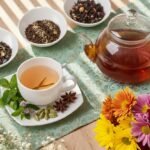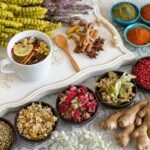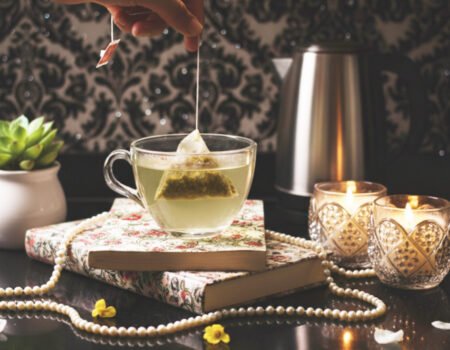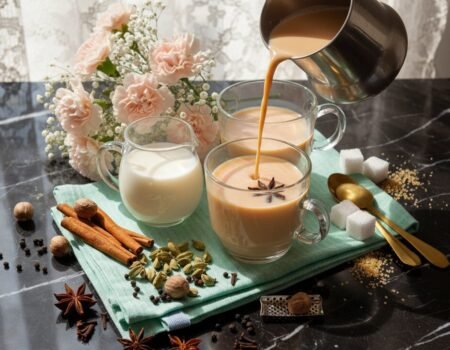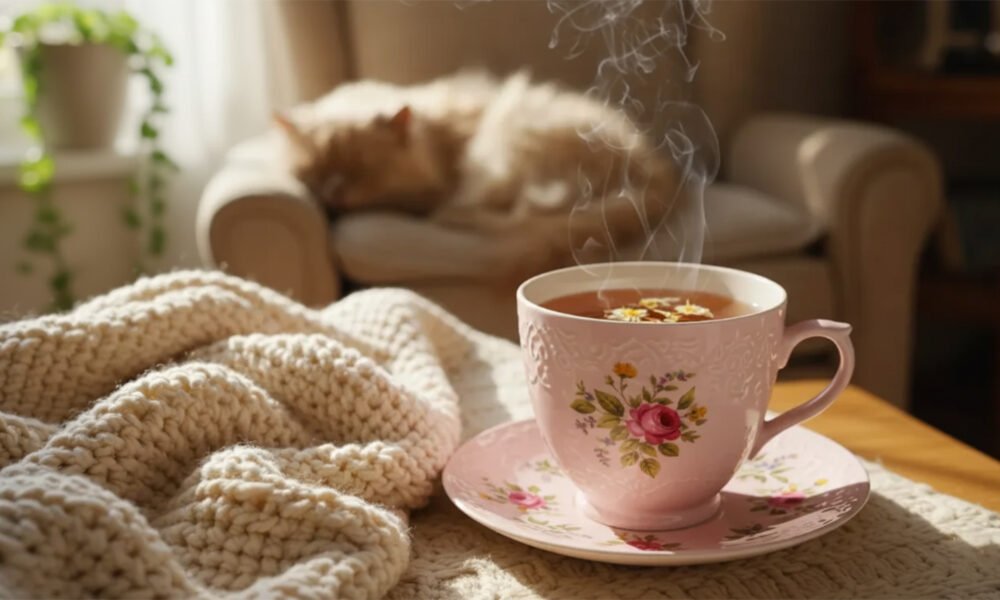
What Types of Tea Have No Caffeine: A Comprehensive Guide
Index
The tea plant Camellia sinensis naturally contains caffeine in its leaves. This plant produces black tea, green tea, white tea, and oolong varieties – all with varying caffeine levels.
But don’t worry! Numerous delicious options exist beyond these traditional teas.
This guide explores truly caffeine-free alternatives like herbal teas, rooibos, and chamomile that deliver wonderful flavors without the stimulant effects. We’ll cover popular blends, taste profiles, and brewing tips to help you find your perfect caffeine-free cuppa.
Key Takeaways
- Truly caffeine-free teas come only from plants other than Camellia sinensis, including herbs, flowers, fruits, and roots.
- Popular caffeine-free options include herbal teas like chamomile, peppermint, ginger, hibiscus, and rooibos, each offering unique flavors and brewing experiences.
- Rooibos tea from South Africa provides a naturally sweet, nutty flavor with zero caffeine, making it perfect for evening consumption.
- Decaffeinated tea differs from caffeine-free tea, as it still contains trace amounts (about 2.5% of original levels) of caffeine.
- For contrast, black tea contains the highest caffeine (64-112 mg per 8 oz /235 ml), while herbal teas contain 0 mg of caffeine.
What Does Caffeine-Free Mean in Tea?
Caffeine-free tea refers to drinks made from plants that naturally contain zero caffeine. These include flowers, herbs, fruits, and roots that steep into flavorful brews without the stimulant effects found in traditional teas.

True caffeine-free options come only from herbal and fruit sources like chrysanthemum or blueberry, which have never contained caffeine in the first place. This differs from decaffeinated tea, which starts with regular tea leaves and goes through a process to remove most—but not all—caffeine content.
Many tea lovers confuse “decaf” with “caffeine-free,” but these terms mean different things. Decaffeinated teas still contain trace amounts of caffeine, typically less than 2.5% of their original levels (often around 2 to 5 milligrams per cup depending on processing and tea type).
For those seeking absolutely zero caffeine intake, only pure herbal infusions like peppermint, chamomile, or rooibos provide complete assurance. These naturally caffeine-free alternatives offer rich flavors and potential health benefits without the jitters or sleep disruption that caffeine might cause.
Let’s explore some popular naturally caffeine-free tea options that might surprise you with their taste and benefits.
Naturally Caffeine-Free Teas
Naturally caffeine-free teas offer a perfect option for those who want to enjoy warm drinks without the stimulant effects. These plant-based infusions come from different sources than traditional tea leaves, giving you all the flavor with none of the buzz.
Herbal Teas

Herbal teas offer a perfect option for anyone wanting to avoid caffeine while still enjoying a warm, flavorful drink. These special brews come from plants other than the Camellia sinensis, making them naturally free of caffeine.
Herbal Teas for Relaxation & Sleep
Calming Evening Companions
- Chamomile – Some people find its mild, apple-like flavor and sweetness helpful for winding down before bedtime
- Lavender – Its floral aroma can relax both mind and body, improving overall sleep quality
- Valerian Root – Has an earthy taste and has been used traditionally for relaxation, though scientific evidence remains mixed
Mood & Anxiety Support
- Lemon Balm – Improves mood through gentle citrus notes combined with stress-reducing compounds that calm anxiety
Digestive & Physical Wellness Teas
Stomach Soothers
- Peppermint – Provides a cooling menthol sensation that freshens breath and offers a refreshing taste
- Ginger – Fights nausea and warms the body from inside out with its spicy kick that reduces inflammation
- Licorice Root – Provides a naturally sweet flavor that requires no added sugar

- Dandelion – Offers a slightly bitter, coffee-like taste that some enjoy as a coffee alternative
Immune System & Health Boosters
Antioxidant Powerhouses
- Hibiscus – Delivers a tart, cranberry-like taste with a vibrant red color
- Rooibos – A plant from South Africa, delivers a nutty, slightly sweet flavor—completely caffeine-free
- Rose Hip – Offers a slightly tart flavor and pretty pink hue
Immunity & Inflammation Fighters
- Turmeric – Provides an earthy, slightly bitter taste and bright yellow color with anti-inflammatory properties
- Echinacea – Features a slightly bitter taste and has been traditionally used during cold season
- Sage – Delivers an earthy, aromatic flavor profile
Custom Blending Options
- Herbal Tea Blends – Combine multiple ingredients for enhanced taste and health benefits, creating unique flavor profiles tailored to your specific wellness goals
Rooibos Tea

While herbal teas offer many caffeine-free options, Rooibos tea stands in a class of its own. This distinct red tea comes from the Aspalathus linearis plant native to South Africa, not from the Camellia sinensis plant that produces true teas.
Rooibos delivers a naturally sweet flavor profile with nutty notes that many tea lovers enjoy without any caffeine boost. People who react badly to caffeine often turn to this relaxing tea as a perfect evening drink.
Its natural sweetness means you can enjoy it plain or with just a touch of honey, making it a versatile caffeine-free choice for any time of day.
Chamomile Tea

Chamomile tea comes from the dried blossoms of German Chamomile flowers (Matricaria chamomilla). This naturally caffeine-free drink offers a perfect option for anyone sensitive to stimulants.
The tea has been traditionally enjoyed as a calming evening beverage. Many tea lovers choose this herbal infusion for its gentle flavor and relaxing properties.
The tea offers a gentle, apple-like flavor that many find soothing before bedtime.
For the best taste without bitterness, steep your chamomile tea for 3-4 minutes in hot water. This herb tea ranks among the most popular caffeine-free options worldwide, making it an excellent choice for evening relaxation.
Peppermint Tea
While chamomile offers floral notes for relaxation, peppermint tea delivers a bold, refreshing experience with its own caffeine-free benefits. This popular herbal infusion comes from the leaves of the peppermint plant rather than the Camellia sinensis used in traditional caffeinated beverages.

The natural menthol in peppermint leaves creates that signature cooling sensation and refreshing taste many tea drinkers love. Unlike matcha tea or yerba maté, peppermint contains zero caffeine, making it perfect for evening consumption.
The absence of stimulants makes peppermint tea different from oolong tea or earl grey, which both contain caffeine that might disrupt sleep patterns. You can safely enjoy this herbal tea at any hour without worrying about staying awake.
Brewing loose leaf peppermint tea creates a more potent flavor than using tea bags. The fresh taste pairs well with honey or lemon for those who prefer sweetened herbal infusions. Tea enthusiasts often recommend steeping peppermint leaves for 5-7 minutes to extract maximum flavor and aromas.
This relaxation tea serves as an excellent alternative to high-caffeine options like pu-erh tea when you need to unwind but still want a flavorful drink experience.
Popular Caffeine-Free Tea Blends
Popular caffeine-free tea blends combine herbs and spices for unique flavors and health benefits. These blends offer exciting options beyond single-herb teas while still keeping you caffeine-free.
Lemon & Ginger Tea

Lemon and ginger tea offers a perfect caffeine-free option for tea lovers seeking both flavor and health benefits. This zesty blend combines the sharp citrus notes of lemon with the warm, spicy kick of ginger root, creating a refreshing drink with a zesty kick.
Ginger tea stands out as a warming beverage with anti-inflammatory properties, while also relieving nausea and morning sickness slightly. Many pregnant women turn to this natural remedy for comfort during their first trimester.
The beauty of this herbal infusion lies in its versatility – you can brew it from fresh ingredients or find it as loose leaf tea in most stores. You might enjoy it with a touch of honey for sweetness or plain to experience the full intensity of its natural flavors.
Next, we’ll explore another popular caffeine-free option that brings vibrant color and tart flavor to your cup – hibiscus tea.
Hibiscus Tea

Hibiscus tea is made from the dried calyx of the Hibiscus sabdariffa plant and is naturally free of caffeine. It is appreciated by many tea enthusiasts for its distinctive tart flavor and vibrant deep red color, which make it stand out among other herbal teas. The tea’s cranberry-like taste and rich crimson hue are unique characteristics that contribute to its popularity. However, pregnant women, nursing mothers, and children under 12 should generally avoid hibiscus tea as it might interfere with their sensitive hormonal balance.
Turmeric ginger tea offers another excellent choice for those seeking caffeine-free alternatives.
Turmeric Ginger Tea

Turmeric ginger tea combines two powerful roots to create a golden-yellow brew with complex flavors. The earthy, slightly bitter notes of turmeric balance perfectly with ginger’s sharp, warming spice, producing a drink that tastes both grounding and invigorating.
You’ll notice the vibrant golden color immediately when brewing this blend – turmeric’s curcumin compounds create that distinctive sunshine hue. The aroma hits you with warm spice notes and a hint of pepper, preparing your senses for the full-bodied experience ahead. We recommend steeping this blend for 5-10 minutes in water just off the boil (around 95°C / 203°F) to extract the full depth of flavor from both roots.
Fresh turmeric and ginger create a more vibrant tea than dried versions, though both work well. You can enhance the natural spiciness with a squeeze of lemon, which also helps brighten the earthy undertones. Adding a teaspoon of honey balances any bitterness while complementing the warming qualities. Some tea drinkers add a pinch of black pepper, which traditional preparations suggest may help with turmeric absorption, though the amounts in tea are quite small.
This warming blend makes an excellent afternoon pick-me-up without the caffeine crash, or a comforting evening drink during colder months. The combination of ginger’s digestive comfort and turmeric’s golden warmth creates a satisfying cup that many reach for after meals.
Teas with the Most Caffeine (for contrast)
Understanding high-caffeine teas helps you make informed choices when seeking caffeine-free alternatives. The following table shows caffeine content in popular teas per 8-ounce serving.
| Beverage Type | Serving Size | Caffeine per Serving (Range) | Caffeine per oz (Concentration) | Notable Characteristics |
|---|---|---|---|---|
| Matcha Green Tea | 8 oz | 60-70 mg | ~7-9 mg | High caffeine, overlaps with black tea; provides focused energy. |
| Standard Black Tea | 8 oz | 40-70 mg | ~5-9 mg | Very wide range; potent varieties can exceed 100 mg. |
| Pu-erh Tea | 8 oz | 30-70 mg | ~4-9 mg | Earthy flavor; wide range depending on type & age. |
| Oolong Tea | 8 oz | 30-55 mg | ~4-7 mg | Moderate caffeine with a unique flavor profile. |
| Green Tea | 8 oz | 25-45 mg | ~3-6 mg | Lower caffeine with high antioxidant content. |
| White Tea | 8 oz | 15-30 mg | ~2-4 mg | Generally the lowest caffeine content among true teas. |

Black tea and Matcha tea usually contain the most caffeine among all tea varieties. Many tea drinkers select black tea specifically for its energy-boosting properties. Oolong offers a middle ground with moderate caffeine levels. White tea surprises many people with its caffeine content, which exceeds some green tea varieties despite its delicate flavor. Green tea provides a gentler caffeine experience while still delivering alertness benefits. The processing methods for each tea type directly impact these caffeine levels. Now let’s wrap up with some final thoughts on selecting the right caffeine-free options for your lifestyle.
Conclusion
You now have a clear map to caffeine-free teas. Herbal infusions like rooibos, chamomile, and peppermint offer natural options without the buzz.
These plant-based drinks provide unique flavors and enjoyable experiences while keeping your sleep cycle intact.
Tea lovers can enjoy these soothing brews any time of day without worry about jitters or insomnia. Next time you crave a warm cup in the evening, reach for these naturally caffeine-free alternatives and relax fully into your night routine.
FAQs
1. What teas are naturally caffeine-free?
Herbal teas or herbal infusions like ginger tea contain no caffeine. These relaxation teas don’t come from the Camellia sinensis plant, which is the source of caffeine in traditional teas.
2. Is decaffeinated tea completely free of caffeine?
Decaffeinated tea still contains small traces of caffeine, unlike truly caffeine-free teas. The process removes most but not all caffeine, leaving about 2-5 mg per cup compared to pure caffeine levels in regular tea.
3. How do herbal teas differ from regular teas?
Herbal teas come from dried fruits, flowers, and herbs rather than the Camellia sinensis plant. They offer various flavors and benefits without the stimulating effects found in Earl Grey tea and other caffeinated options.
4. Can I drink caffeine-free teas at night?
You can enjoy caffeine-free teas before bed without worry. Many relaxing teas like lavender are enjoyed before bedtime, with some people finding them helpful for winding down, unlike beverages with caffeine such as Coca-Cola.
5. What are popular options for caffeine-free teas?
Rooibos, peppermint, and chamomile rank among the most popular caffeine-free options. These herbal infusions offer unique flavors and potential health benefits while allowing you to avoid caffeine completely.
References
- https://www.teavivre.com/info/caffeine-free-tea-and-decaffeinated-tea.html?srsltid=AfmBOorYLwutZbEGR6SZ2kFCSTrVT3fZjzfD02Mi1tOeEnZpmU_HA3gr
- https://artfultea.com/blogs/101/types-of-tea-a-comprehensive-guide?srsltid=AfmBOoo-LZTVuFejLZ08Q4E0oeaAPiSVnCfUspkWv1GyLQGm7xpwwP4H
- https://pmc.ncbi.nlm.nih.gov/articles/PMC11521711/
- https://www.republicoftea.com/blog/tea-library/does-rooibos-tea-have-caffeine/tl-044/?srsltid=AfmBOor3vQH-BPKUR6MEANBivyu58_yqvM-dH0n5hD4a1OOg5WqekLt1
- https://www.whittard.com/discover/tea-tips/a-guide-to-rooibos.html
- https://www.theteamakers.co.uk/blogs/news/the-ultimate-guide-to-chamomile-tea?srsltid=AfmBOooOPH2vWpNSZ3xu7EYf5Gu0fB6RnGwiComD-kpz-sRCWLLqF1wz (2024-09-23)
- https://artfultea.com/blogs/101/types-of-tea-a-comprehensive-guide?srsltid=AfmBOoo8EWp4Je5Z_CyKkI1C2Wt2m36LdGo_Yu-gH1QdSK3HVRcOs7Yc
- https://teapigs.com.au/blogs/blog/teas-that-are-caffeine-free?srsltid=AfmBOoqvsgM3Vf0tYS_qQeoQ_WrcuPidKRaUGzHiFGv335mqgzPKFIbM (2024-05-28)
- https://www.redrockteahouse.com/blogs/articles/the-best-caffeine-free-teas?srsltid=AfmBOorQsaw5N2jZFWbemwM6e4eKLL9_518qO3xMBAEdgWvzOFolznvQ (2025-03-10)
- https://www.redrockteahouse.com/blogs/articles/the-best-caffeine-free-teas?srsltid=AfmBOopnBfxw0cK9C_DvV735T-26kwqibjtU85hDv4rZ4xw0u0UmqRcm
- https://www.drinkteaa.com/blogs/healthy-lifestyle/hibiscus-tea-benefits?srsltid=AfmBOop7nkkXLn_70x-W2IDRVj23fp9ZUsEN6tnnK5L0FOBmscGw3juI (2024-07-23)
- https://fullleafteacompany.com/blogs/news/guide-to-turmeric-tea-benefits-blends-and-wellness?srsltid=AfmBOoqJQpg7Hyul77_zkfLcPQxYVX9y1tjOEMCJ5ussZ3BHNA4emj6F
- https://www.medicalnewstoday.com/articles/319638
- https://www.medicalnewstoday.com/articles/which-tea-has-the-most-caffeine (2022-03-25)
- Examine.com

